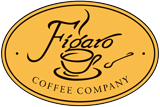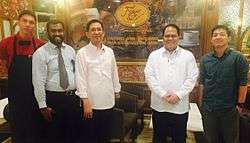Figaro Coffee
The Figaro Coffee Company (Figaro) is a Philippine coffee company and coffeehouse chain that works on the franchise model. As of September 2013, it had 63 outlets in Philippines, Qatar, Saudi Arabia and Papua New Guinea. The company does not own roasting facilities, but rather employs the facilities of a sister company, Boyd's Coffee Company.[2] Figaro currently has 90 outlets worldwide.[3]
 | |
Formerly | "F" store (1993) |
|---|---|
| Private | |
| Industry | Coffee shop |
| Founded | November 1993 Glorietta, Makati, Philippines |
Number of locations | 63[1] (2019) |
| Products |
|
| Website | www |
History

Figaro was established in November 1993 by seven college friends[4] (including Pacita "Chit" Juan, who was the CEO of Figaro, and Reena S. Franciso, who became its COO till 2008) as a small kiosk in Glorietta mall (Makati, Manila) selling fresh ground coffee and tea paraphernalia. Two of the founders, including Pacita Juan and Reena S. Franciso Pacita, were classmates at the University of the Philippines, where Pacita had studied Hotel and Restaurant Administration. Pacita in her family business, then decided to start a coffee shop, something that she had earlier set out with while still in college.[5][6] The first outlet was called the "F" store and employed one managing partner and two employees.[7] The shop had coffee and tea paraphernalia including fresh ground coffee beans. After a few trying initial months, the owners decided to give the coffee shop a name. In April 1994, the founders chose the name "Figaro", inspired by the opera Barber of Seville.[8] Pacita and her friends wanted to set up a place where "Filipinos can get the perfect coffee and all the necessary accoutrements for coffee making”.[9]
Pacita subsequently became the CEO of Figaro, a position she retained till 2008 when the chain was sold to Jerry Liu, a Taiwanese businessman. Jose Fernando Alcantara took Pacita's place in 2008, followed by CrisMel Verano in 2009.[10] Reena remained the Chief Operating Officer till 2008.
In 1998, Pacita met Father Roger Bagao, a coffee farmer and priest from Tagaytay City who headed a farmers' coffee cooperative. In 1999, Figaro introduced Cafe Barako, as part of the "Save the Barako" campaign. Around the same time, the Figaro foundation was set up, to help coffee farmers grow coffee profitably.
In 2002, while at Figaro, Pacita became the President of the National Coffee Development Board (now Philippine Coffee Board Inc). After Figaro, Pacita went on to set up ECHOstore.[11]
In 2005, Figaro opened its first overseas outlet in Shanghai. By mid-2006, Figaro had grown to 53 outlets, most of which were in Metro Manila, with two in Baguio and one in Davao. In 2006 (and again in 2009), Figaro voiced plans on an IPO in Makati Stock Exchange; however, those did not materialize. In December 2006, Figaro opened its first branch in Cebu city, and opened another 12 stores in 2007.[12] 2008 marked a turning point for Figaro, as Pacita and Reena left it, while the Tanseco family became its majority shareholders.[13] In 2009, the company underwent financial restructuring and closed some of its overseas branches.[14]
Some trademarks of Figaro continue to be owned by Pacita and are currently contested in court.[15] In the same year, Figaro began to experiment in retailing and exporting organic coffee.[16]
In April 2013, the franchisee manager of Figaro, Mike Barret, informed the media of their intent to open outlets in Fiji and Vietnam.[17][18][19]
See also
References
- "Cafes | Figaro Coffee Company". www.figarocoffee.com.
- Nuguid-Anden, Charmaine. Figaro Coffee Company Case Study (PDF). UK: U.N Volunteers - New Academy of Business. p. 4. Archived from the original (PDF) on 2015-09-23. Retrieved 2013-09-05.
- "Our Story | Figaro Coffee Company". figarocoffee.com. Retrieved 2020-04-08.
- "Profile and past jobs - Reena Francisco". Linked In. Archived from the original on 5 September 2013. Retrieved 5 September 2013.
- Sanford, Alpha Miguel (13 October 2012). "Success story : Pacita Juan, entrepreneur". A.M.S Daily. Retrieved 5 September 2013.
- "Figaro - Official facebook page". Facebook. Retrieved 5 September 2013.
- "Figaro Coffee Shop". www.franphil.com. Retrieved 5 September 2013.
- "About Figaro Coffee Company". Official website - Figaro. Archived from the original on 24 August 2013. Retrieved 5 September 2013.
- Nuguid-Anden, Charmaine. Figaro Coffee Company Case Study (PDF). UK: New Academy. p. 3. Archived from the original (PDF) on 2015-09-23. Retrieved 2013-09-05.
- Reyes, Mary Anne (28 August 2011). "Row at Figaro". The Philippine Star. Retrieved 6 September 2013.
- Ravanona, Anne (2012). "Interview with Pacita Juan". Global Leader Post. Retrieved 5 September 2013.
- Felix, Rocel (28 August 2006). "Figaro Coffee prepares for initial public offering". The Philippine Star. Retrieved 6 September 2013.
- "Figaro all set for expansion". GMA Network. 24 February 2009. Retrieved 6 September 2013.
- Go, Marianne (12 August 2009). "Figaro needs P200 million to pay debts". The Philippine Star. Retrieved 6 September 2013.
- Poblete, Johanna (26 June 2009). "Ex-Figaro CEO pushes ahead with new coffee chain". ABS CBN News. Retrieved 6 September 2013.
- Bongcac, Doris (11 December 2008). "Figaro studying organic coffee market". Philippine Inquirer. Archived from the original on 6 September 2013. Retrieved 6 September 2013.
- "Figaro eyes Fiji". Inside Retail Asia. 29 April 2013. Retrieved 6 September 2013.
- "Coffee Chain Figaro (Philippine) to Bring its Franchise to Fiji". World Franchise Associates. 24 April 2013. Retrieved 10 September 2013.
- Valemai, Ropate (24 April 2013). "Coffee chain considers Fiji franchise". The Fiji Times. Retrieved 6 September 2013.